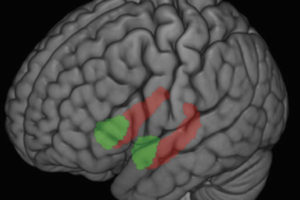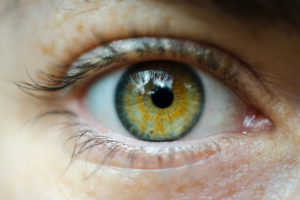Brain tests at UW–Madison suggest that autistic children shy from eye contact because they perceive even the most familiar face as an uncomfortable threat.
The work deepens understanding of an autistic brain’s function and may one day inform new treatment approaches and augment how teachers interact with their autistic students.
Tracking the correlation between eye movements and brain activity, the researchers found that in autistic subjects, the amygdala — an emotion center in the brain associated with negative feelings — lights up to an abnormal extent during a direct gaze upon a non-threatening face. Writing in the March 6 issue of the journal Nature Neuroscience, the scientists also report that because autistic children avert eye contact, the brain’s fusiform region, which is critical for face perception, is less active than it would be during a normally developing child’s stare.
“This is the very first published study that assesses how individuals with autism look at faces while simultaneously monitoring which of their brain areas are active,” says lead author Kim Dalton, an assistant scientist at UW–Madison’s Waisman Laboratory for Brain Imaging and Behavior. Dalton measured eye movements in conjunction with magnetic resonance imaging (MRI), a sophisticated technology that allows researchers to “see” a brain in action.
Notably, the UW–Madison study overturns the existing notion that autistic children struggle to process faces because of a malfunction in the fusiform area. Rather, in autistic children the fusiform “is fundamentally normal” and shows only stunted activity because over-aroused amygdalas make autistic children want to look away, says senior author Richard Davidson, a UW–Madison psychiatry and psychology professor who has earned international recognition for his work on the neural underpinnings of emotion.
“Imagine walking through the world and interpreting every face that looks at you as a threat, even the face of your own mother,” Davidson adds. Scientists have in the past speculated that the amygdala – which has been implicated in certain anxiety and mood disorders – plays a role in autism, but the study directly supports that idea for the first time.
“Imagine walking through the world and interpreting every face that looks at you as a threat, even the face of your own mother."
An increasingly publicized developmental disability, autism greatly weakens the capacity to socialize and communicate normally. The tendency to avoid eye contact is one of the most pervasive traits among autistic children, says Dalton. The characteristic is a problem because eyes, in particular, are a crucial source of “subtle cues that are critical for normal social and emotional development,” Dalton says.
Dalton’s work comprised two studies. In the first, researchers placed autistic children inside an MRI scanner and showed them pictures of faces with both emotional and neutral expressions. The children had to press one of two buttons to indicate whether a face showed a blank or expressive face. Throughout the process, the researchers used precise eye-tracking technology to measure exactly which parts of the face study participants were looking at and for how long. Normally developing children far outpaced the autistic study participants in identifying expressions correctly.
During the second study, the researchers again placed subjects in MRI machines and showed them photographs of both familiar and unfamiliar faces. They monitored eye movements and brain activity, and once again, autistic subjects performed considerably more poorly than normally developing participants.
In the future, the findings could help scientists “train autistic children to look at a person’s eye region in a more strategic way, like when the person may not be looking directly at them,” says Davidson. Researchers eventually could assess whether such approaches improve the ability to make eye contact and whether they might even induce positive developmental changes in the brain.
Because autism is more inheritable than any other psychiatric condition, researchers also could start to explore the genetic mechanisms underlying hyperactive amygdalas — “a completely uncharted research territory,” says Davidson. And if the autistic amygdala is found to be overactive from infancy, the knowledge could help doctors implement intervention approaches right from an early age.
– Paroma Basu






